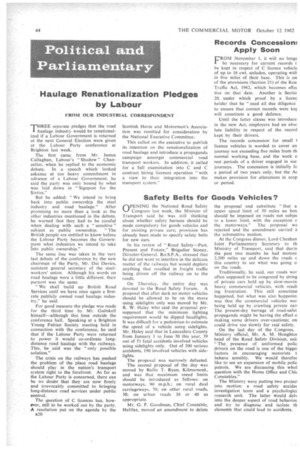Safety Belts for Goods Vehicles?
Page 46

If you've noticed an error in this article please click here to report it so we can fix it.
nPENING the National Road Safety "Li Congress last week, the Minister of Transport said he was still thinking about whether safety harness should be made compulsory for goods vehicles and for existing private cars; provision has already been made to specify safety belts for new cars.
In his review of "Road Safety—Past, Ptesent and Future," Brigadier Stoney, Director-General. Ro.S.P.A., stressed that he did not want to interfere in the delicate matter of the railways but would deplore anything that resulted in freight traffic being driven off the railway on to the roads.
On Thursday, the entire day was devoted to the Road Safety Forum. A proposal that after dark no motor vehicles should be allowed tO be on the move using sidelights only was moved by Mr. R. W. Haley who said the proposal presupposed that the minimum lighting requirement would be dipped headlights. It was difficult for a pedestrian to estimate the speed of a vehicle using sidelights. Mr. Haley said that in Lancashire County from January 1 to June 30 this year', 39 out of 51 fatal accidents involved vehicles using sidelights only. Out of 300 serious accidents, 190 involved vehicles with sidelights.
The proposal was narrowly defeated.
The second proposal of the day was moved by Bailie T. Ryan, Kilmarnock, and was that maximum speed limits should be introduced as follows: on motorways, 90 m.p.h.: on rural dual carriageways, 70; on other rural roads, 50; on urban roads 30 or 40 as appropriate.
Mr. G. F. Goodman, Chief Constable, Halifax, moved an amendment to delete the proposal and substitute "that a upper speed limit of 50 miles an hoc should be imposed on roads not subjec to a lower limit, with the exception c the motorways." The proposal wa rejected and the amendment carried a the substantive motion.
At the Congress dinner, Lord Cheshart Joint Parliamentary Secretary to th Ministry of Transport, said that durin the past two months he had motore 2,500 miles up and down the roads c this country to see what was going o on the roads.
Traditionally, he said, our roads wer often supposed to be congested by string of private cars held up by slow-movin heavy commercial vehicles, with resuli ing frustration. This still sometime happened, but what was also happenin was that the commercial vehicles wer being held up by 'crawling private can The present-day barrage of road-safet propaganda might be having the effect making some drivers .over-cautious; on could drive too slowly for real safety.
On the last day Of the Congress, Ministry -official, Mr. A. M. Houghtot head of the Road Safety Division, sale " The presence of uniformed polic drivers on the road is one of the biggci factors in encouraging motorists t behavesensibly. We would therefor like to see an expansion of mobile polic patrols. We are discussing this whol question with the Home Office and Chit Constables."
The Ministry were putting two projeci into motion: a road safety accider investigation team and a psychologia research unit. The latter would del% into the deeper aspect of road behaviot and try to diagnose and isolate •th elements that could lead to accidents.




















































































































